
There was an old woman who rode on a broom,
With a heigh, gee-ho, gee-humble;
And she took her old cat behind for a groom,
With a bumble, bumble, bumble. — From Gems from Mother Goose
When Gems from Mother Goose came out in 1899, the standard witch description depicted an older woman (often with green tinted skin) who wore a black pointed hat, had a familiar (most often a black cat) and flew on a magical broom. Most folks thought witches were evil. How did this image take our imaginations?
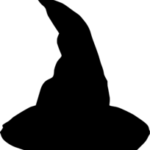
Conical Hats
Illustrations usually show witches wearing conical hats. The hats have no magical powers, however in the 15th and 16th centuries conical hats were fashionable in the upper classes. And, since most stories about witches appear at this time, the hat became a sort of fashion statement of Witchery.
Black Cats & Other Familiars
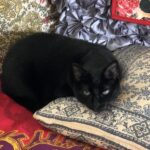
A familiar functions as an individual witch’s magical helper. The witch compensates her helpers with food and a place to live. Besides cats, familiars might be dogs, toads, birds, spiders, flies, bees, rats, mice, cows, ferrets, rabbits, bears, and according to at least one source, snails.
However, in early modern Europe, witch hunters most often associated witches with black cats. Cats could see in the dark and blend into the shadows. Some thought a witch could change her shape into that of a black cat. Regardless, by the 20th century black cats were objects of superstition and thought to bring bad luck, with or without supernatural powers.
Besoms & Brooms

If you refer back to the first illustration, you’ll notice that the broom the old woman rides is more correctly a besom, such as the one pictured here which is the prototype for modern brooms.
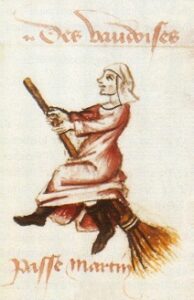
The word besom comes from the Old English, besma, which became besom, which became broom. Besoms have been used since ancient times to cleanse the home from evil spirits as well as dirt. They were often used in wedding ceremonies in which the couple clasped hands and jumped over the besom as a symbol of their commitment to each other and their new home. The broom’s handle held masculine energies while the bristles were feminine. In general, the broom was associated with women as a symbol of domesticity.
The association of witches and brooms could be due to a pagan fertility ritual known as the Broomstick Dance. Farmers would leap and dance astride poles, pitchforks or brooms in the light of a full moon to encourage their crops to grow.
Incidentally, 15th and 16th century illustrations show witches riding stools, cupboards, wardrobes and cooking forks as well as brooms.
Witch’s Brews

Witches have a reputation for whipping up their spells and potions in a cauldron. During the 15th and 16th centuries, most households used at least one cauldron for cooking. Today, not so much, though modern witches may use a cauldron to prepare ingredients for spells.
Cauldrons do have a symbolic meaning. They symbolize both the Goddess and her womb and also can be used to represent the elements of fire and water.
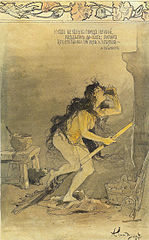
It is thought that during the Middle Ages, brews, ointments, and salves were made by people later accused of witchcraft. Mixtures that included Atropa belladonna (deadly nightshade), Hyoscyamus niger (henbane), Mandragora officinarum (mandrake) and Datura stramonium (jimsonweed). The resulting mixture had hallucinogenic properties. Ingestion of the chemicals by eating the plants or drinking their extracts caused severe abdominal discomfort. However, further observations revealed that the mixture could be absorbed through sweat glands in the armpit or via the mucous membranes in the rectal or vaginal areas of the body. And, it appears that broomsticks were a perfect means of applying the mixture to these areas of the body. When the hallucinations took effect, the accused individual reported the sensation of flying.
Flying
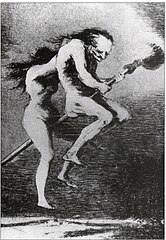
In 1324 Lady Alice Kyteler, an Irish widow, was tried for sorcery and heresy. Witnesses reported they discovered ‘a pipe of ointment wherewith she greased a staff upon which she abled and galloped thru thick and thin.’
The first accused witch who confessed to riding a besom was a priest for the Saint-Germain-en Laye who was arrested in 1453, confessed under torture and was imprisoned for life.
Martin le Franc published the first illustrations of witches flying on brooms in his Le Champion des Dames. The women wore the type of headscarves worn by Waldensians, a Christian sect branded as heretics by the Catholic Church.
Modern Halloween Witchery
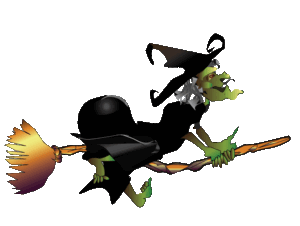
Today, some witches, like Snow White’s stepmother, are depicted as evil witches, however most, for example Cassie Nightingale in the Good Witch on the Hallmark Channel, have a more benevolent image. In contemporary fiction witches use their powers for good, and in illustrations they take on the whimsical good will associated with happy childhood memories. The witch above with her greenish skin, besom and conical has a playful aspect.
Have a Safe & Happy Halloween!
Illustrations
Gems from Mother Goose, 1899.
WikiWitch Symbol.
Line Drawing of Besom Broom by Pearson Scott Foresman.
Photo by Author.
Drawing of Witch by Martin Le Franc. 1541.
Witch’s Cauldron from webcomic Pepper&Carrot by David Revoy.
By Anton Kandaurov. 1899.
By Santiago Camado.
Gems from Mother Goose. 1899
Sarah Coughlin. “Cauldrons, Broomsticks & Pointed Hats.” Refinery. Oct. 29, 2019.
Irynas. Unfamiliar Familiars. Folklore & Public Culture. Dec. 2, 2021.
David Kroll. “Original of Witches Riding Broomsticks.” Forbes. Oct. 31, 2017.
Sarah Pruitt. “Why Do Witches Ride Brooms?” History. Aug. 9, 2023.

Sandra Wagner-Wright holds the doctoral degree in history and taught women’s and global history at the University of Hawai`i. Sandra travels for her research, most recently to Salem, Massachusetts, the setting of her new Salem Stories series. She also enjoys traveling for new experiences. Recent trips include Antarctica and a river cruise on the Rhine from Amsterdam to Basel.
Sandra particularly likes writing about strong women who make a difference. She lives in Hilo, Hawai`i with her family and writes a blog relating to history, travel, and the idiosyncrasies of life.

